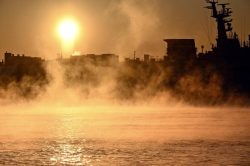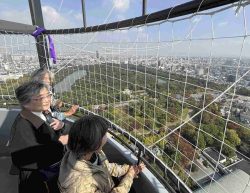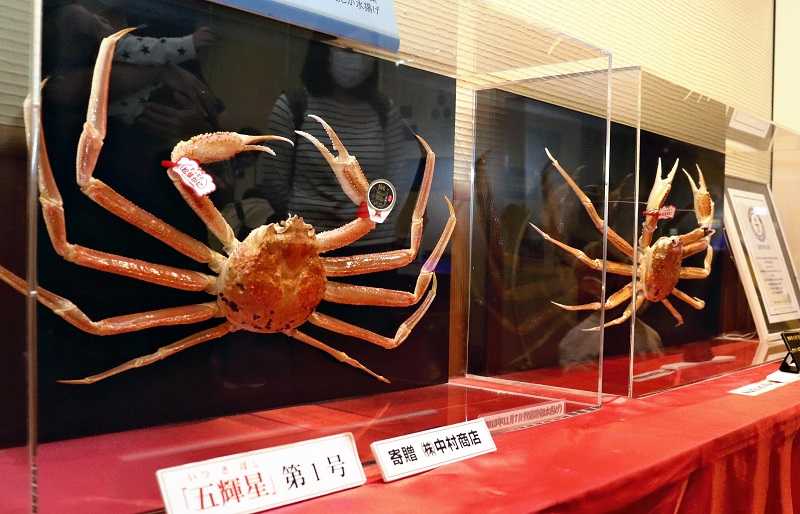
Preserved snow crabs are seen at Kanikko Kan in Tottori.
10:48 JST, November 6, 2022
TOTTORI — A small aquarium mainly exhibiting crabs keeps drawing in families with young children in Tottori Prefecture, one of the largest crab landing areas in Japan.
Tottori Karo Crab Aquarium, nicknamed Kanikko Kan, is located in Tottori City’s Karo district, which includes part of the city’s coastal area. Nearby is Tottori Port, also known as Karo Port, where crabs, a winter delicacy, are brought in from the Sea of Japan.
I visited the aquarium after hearing that its popularity exceeded expectations at the time of its opening. The word kanikko conjures up the image of a small cute crab in Japanese, and indeed, I noticed a cute crab logo in front of the entrance.
“It tells children that crabs are the star of our aquarium. We hope that they will become more interested in the creatures,” says Masako Nishimura, the aquarium manager.
1,700 aquatic animals
The facility opened in 2003 to provide a place to learn about aquatic life with a focus on crabs. It also provides information about Tottori Prefecture’s representative fishery resources and promotes tourism. In addition to exhibiting crabs hauled in at the nearby Karo Port and other ports in the prefecture, the aquarium also includes roughly 1,700 freshwater and marine animals of about 160 species.
In the exhibit room at the end of the building, there are crab-related multiple choice questions, such as “When do crabs produce bubbles?” along with explanatory plates handmade by the staff.
“I can learn about living creatures while having fun, and I never get bored with it,” said a 9-year-old girl, who added she often visits the aquarium with her family.
Immediately to the left of the entrance is a line of large, exquisitely preserved crab specimens. Visitors can view an Itsukiboshi premium-brand crab with a carapace width of 14.6 centimeters and a weight of 1.28 kilograms. It was hauled in at Karo Port in November 2018 and was recognized by Guinness World Records as the “Most expensive crab sold at auction.” A 2.7-meter-long Japanese spider crab is also on display. Many visitors stopped to take photos.

A spider crab is seen at the Kanikko Kan aquarium in Tottori.
Visitors on the rise
When the aquarium first opened, it expected to see about 110,000 visitors per year, but the actual number of visitors was nearly 200,000 in the early days after its opening. The number exceeded 200,000 in fiscal 2011 and continually broke this threshold over the years.
The aquarium was originally operated by the Tottori prefectural government, but in 2019 it was transferred to the management of the Tottori Prefectural Tourism Organization, a prefectural affiliate. The new management began selling plush toys, promotional coasters and other revenue-generating activities.
These efforts brought a record 353,000 visitors to the aquarium in fiscal 2019, with its annual revenue amounting to several million yen.
The aquarium has also tried to enhance its appeal, such as by creating a much requested jellyfish exhibit by installing a special circular tank. Additionally, the space in front of the building has became a playground with rental equipment.
Fish feeding
To prevent infection during the pandemic, the aquarium has suspended its touch tank, which allowed visitors to touch starfish, sea urchins and hermit crabs, as well as coloring and origami activities. Instead, its flounder and whitebait feeding experience, which had originally been held on weekends and holidays from May to October, became a year-round event.
“It’s so cute that the fish eats so much,” said a 3-year-old boy from Kyoto Prefecture, who fed the flounder.
In winter, when the fish tend to lose their appetite, the aquarium plans to conduct tours of areas that are normally off-limits to let visitors observe the treatment of illnesses and the rearing of animals.
“I hope that with the pandemic contained, our facility will gradually return to a place where people can see, touch and be around aquatic animals,” said Aquarium Director Masao Osaki.
Extend your trip!
Lake Koyama
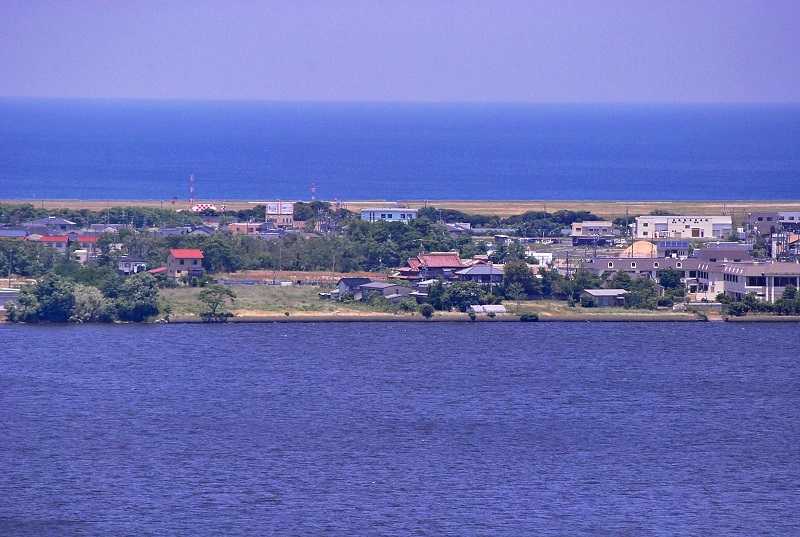
Lake Koyama in the foreground and the Sea of Japan, behind, are seen from the observatory on Aoshima island.
With a circumference of 18 kilometers and an area of 6.8 square kilometers, Lake Koyama used to be an inland bay and was still connected to the ocean about 450 years ago. The Sendai River and other rivers carried sediment into it over many years and sand dunes developed on the north side, eventually cutting the lake off from the Sea of Japan.
The lake has five islands, and the largest one, Aoshima, is connected by a 200-meter bridge to the southern shore. Visitors can take in the view of the massive lake and also the Sea of Japan from the observatory on the island.
How to get there
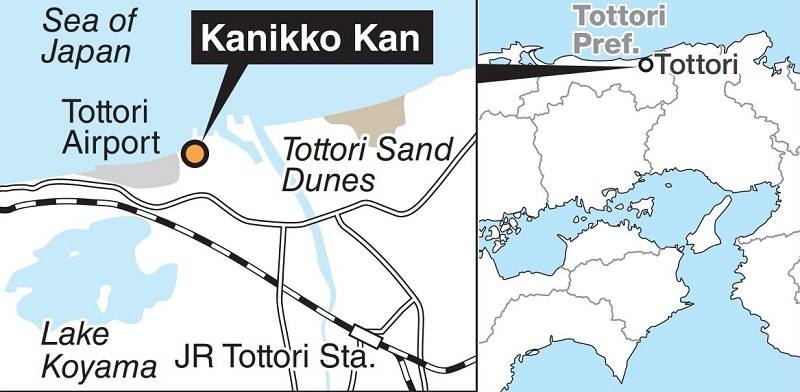
Kanikko Kan is about a 20-minute drive from JR Tottori Station and four minutes by bus from Tottori Airport. Admission is free. Hours are from 9 a.m. to 5 p.m. Last admission is 15 minutes before closing. The Karoichi seafood market and the Wattaina market, where you can buy fresh local agricultural products, are located at the same site.
"Features" POPULAR ARTICLE
-

Sanrio to Open Museum in Yamanashi Pref. Dedicated to Founder, Exhibits Include Hello Kitty, Other Characters
-

Autumn Foliage Surrounds Visitors to Tokyo’s Showa Kinen Park
-

My Daughter No Longer Speaks to Me, But I Want to See Her and My Grandchild
-

Kumamoto: Public Bath Refurbished as Library Where You Can Chat, Take Photos
-

Frozen Vegetables: Demand Rises for Convenient, Tasty Domestic Produce
JN ACCESS RANKING
-

Keidanren Chairman Yoshinobu Tsutsui Visits Kashiwazaki-Kariwa Nuclear Power Plant; Inspects New Emergency Safety System
-

Imports of Rare Earths from China Facing Delays, May Be Caused by Deterioration of Japan-China Relations
-

Tokyo Economic Security Forum to Hold Inaugural Meeting Amid Tense Global Environment
-

University of Tokyo Professor Discusses Japanese Economic Security in Interview Ahead of Forum
-

Japan Pulls out of Vietnam Nuclear Project, Complicating Hanoi’s Power Plans



